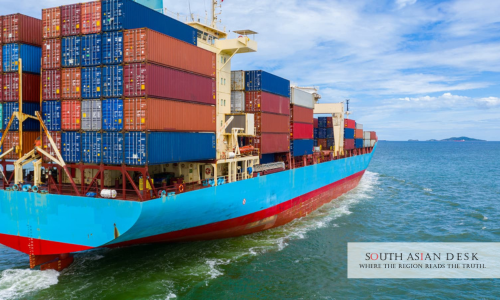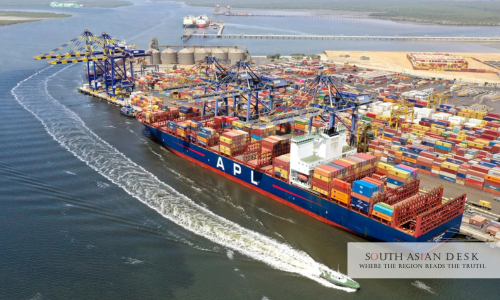KARACHI: Ninth-place achieved for Port Qasim World Bank ranking in the Container Port Performance Index on Monday, August 25, 2025, marking it among the top improving ports worldwide. The index, released by the World Bank in partnership with S&P Global Market Intelligence, highlights a 35.2 point performance gain from 2020 to 2024.
Federal Minister for Maritime Affairs Muhammad Junaid Anwar Chaudhry announced the milestone at 4:35 PM, crediting government reforms and private investments. This Port Qasim World Bank ranking underscores Pakistan’s push to bolster its maritime sector against global disruptions.
The Port Qasim World Bank ranking carries weight in South Asia, where efficient ports drive 90 per cent of regional trade volumes. As neighbours like India advance their facilities, Pakistan’s gains position it as a viable alternative hub for Central Asian and Middle Eastern cargo reroutes, potentially easing export bottlenecks and attracting over PKR 50 billion in logistics investments by 2026. This development aids economic recovery in a region hit by Red Sea tensions and rising freight costs.
Port Qasim CPPI 2024: Key Performance Gains
The Container Port Performance Index evaluates 403 ports across 200 countries based on vessel turnaround times and container handling efficiency. Port Qasim’s score rose to 42.8 in 2024, reflecting streamlined operations and reduced dwell times for cargo. Officials attribute this Pakistan port improvement World Bank recognition to targeted upgrades, including digital tracking systems and 24/7 berth availability.
Federal Minister Junaid Anwar Chaudhry stated the Port Qasim CPPI 2024 results as a “matter of national pride”. He noted the port’s jump from lower tiers in 2020, driven by regulatory tweaks and technology adoption. “The inclusion of Muhammad Bin Qasim Port among the world’s top 20 improving ports is a reflection of our continuous efforts to modernise port operations, adopt global best practices, and enhance efficiency,” Chaudhry said in an official release.
Port Qasim handled 1.8 million twenty-foot equivalent units last year, up 12 per cent from 2023. The facility now processes ships with capacities exceeding 12,000 containers, thanks to partnerships with operators like DP World’s Qasim International Container Terminal. These efforts align with the World Bank’s emphasis on foreland connectivity—links to global shipping lanes—and hinterland integration via rail and road networks.
Comparisons reveal Port Qasim’s edge over regional peers. India’s Jawaharlal Nehru Port ranked tenth for improvements, with a 28 point gain, while Colombo in Sri Lanka lagged at 45th due to congestion issues. Globally, Ecuador’s Posorja led with a 72.8-point surge, followed by Sweden’s Gothenburg and France’s Marseille. Nigeria’s Tin Can Island and Egypt’s Port Said also featured in the top 10, showcasing developing nations’ resilience.
Pakistan Port Improvement World Bank: Reforms Driving Change
Pakistan’s maritime strategy underpins the Port Qasim World Bank ranking. The government allocated PKR 15 billion for infrastructure in the 2025 budget, focusing on dredging and automation. Chaudhry announced clearance for a channel-deepening project, set to commence next month, allowing access for ultra-large vessels and boosting annual throughput by 20 per cent.
Rear Admiral Moazzam Ilyas (Retd), Chairman of the Port Qasim Authority, praised the workforce’s role. “This acknowledgment by the World Bank is a testament to the commitment of the entire PQA team,” Ilyas said. “We will continue to invest in innovation, digitalisation, and infrastructure to further elevate our global standing.” His comments highlight collaborative gains with private entities, which manage 70 per cent of terminal operations.
The Port Qasim CPPI 2024 metrics stem from over 175,000 vessel calls analysed between 2020 and 2024. The World Bank report notes South Asia’s exceptional recovery, with average scores surpassing pre-pandemic levels despite 2024’s Red Sea disruptions. Pakistan’s ports, including Karachi and Gwadar, contribute to this trend, handling 60 per cent of the nation’s seaborne trade worth USD 50 billion annually.
Challenges persist. Geopolitical shifts, including Houthi attacks, inflated shipping costs by 30 per cent this year, stalling maritime growth. Yet, the Pakistan port improvement World Bank nod signals adaptability. Experts predict this will cut exporter delays from 72 hours to under 48, enhancing competitiveness against Dubai’s Jebel Ali.
Background: Evolution of Port Qasim
Port Qasim, operational since 1980, serves as Pakistan’s second-busiest gateway after Karachi Port. Initial developments focused on industrial zones for steel and cement exports. By 2010, container traffic doubled amid China-Pakistan Economic Corridor investments. The 2020-2024 period saw a pivot to efficiency amid COVID-19 supply chain breaks.
World Bank data shows Port Qasim’s initial 2020 score at 7.6, hampered by manual processes and power outages. Reforms introduced automated gates and AI-driven crane scheduling, yielding the 35.2-point uplift. This mirrors broader South Asian trends, where ports like India’s Mundra invested in green tech to meet sustainability goals.
The index’s methodology prioritises total vessel time in port, a proxy for reliability. Ports scoring above 40, like Port Qasim at 42.8, attract premium liners. Regional data indicates South Asia’s ports improved 15 per cent on average, outpacing Africa’s 8 per cent gain but trailing East Asia’s 22 per cent.
Port Qasim World Bank Ranking: Economic Ripple Effects

This achievement bolsters Pakistan’s export sectors, particularly textiles and agriculture, which rely on timely shipments. Importers benefit from lower demurrage fees, estimated at PKR 2 billion saved yearly. The ranking also elevates investor confidence; DP World plans a PKR 10 billion expansion for cold-chain facilities.
In a statement, World Bank Transport Director Nicolas Peltier-Thiberge remarked on such gains: “Even amid multiple shocks, developing country ports are finding ways to adapt, improve, and maximise value.” His words resonate with Pakistan’s context, where the facility now links to the China-Pakistan Economic Corridor, facilitating overland routes to Xinjiang.
Trade analysts forecast a 5 per cent rise in foreign direct investment for logistics by 2026, spurred by the Port Qasim CPPI 2024 visibility. This positions Pakistan against rivals like Bangladesh’s Chattogram, which ranks 120th overall.
What’s Next for Pakistan Port Improvement World Bank Efforts
Future plans centre on integration. The ministry targets full digital customs clearance by mid-2026, reducing paperwork by 80 per cent. Gwadar Port’s parallel upgrades will create a dual-hub model, handling 5 million TEUs combined by 2030.
Chaudhry outlined priorities: “Our aim is to transform Pakistan’s maritime gateways into drivers of economic growth, regional integration, and prosperity.” Investments in rail links to inland depots and eco-friendly cranes will sustain momentum.
The Port Qasim World Bank ranking sets a benchmark. As disruptions evolve, sustained reforms will determine if Pakistan cements its role in South Asia’s trade architecture.
Published in SouthAsianDesk, September 28th, 2025
Follow SouthAsianDesk on X, Instagram, and Facebook for insights on business and current affairs from across South Asia.






